Peterborough Electric Tramways
History
Peterborough's 3ft 6ins-gauge overhead electric tramway was owned by the Peterborough Electric Traction Company, which was itself a subsidiary of the much larger British Electric Traction Company Ltd; the BETCo was a concern which, over the course of its history, either owned, part-owned or leased almost 50 tramway concerns across the British Isles.
In 1899, the BETCo made an application to build a tramway system in Peterborough — under the Light Railways Act of 1896 — and though granted in 1900, it only authorised the construction of lines to the north of the River Nene, planned lines to the south being rejected as a result of objections from Peterborough Corporation and the Great Eastern Railway. Construction began on the 12th May 1902, the PETCo being registered to operate the system on the 5th August 1902, and electric services commencing on the 24th January 1903. The system reached its final size of 5.31 miles on the 28th March 1903, with the opening of the line to Newark.
The system comprised three lines, the hub being at the Market Place in Long Causeway. From here, the line ran northwards to the junction of Westgate and Midgate, where it divided, one route running eastwards then northeastwards via Eastfield Road to Newark, the other running westwards along Westgate before turning into Lincoln Road, which it followed to Walton in the northwest; the remaining line branched off this latter route northwards along Dogsthorpe Road to Dogsthorpe.
The tramway does not appear to have been much of a financial success in its early years, and though dividends were paid, they tended to be small and irregular. Against this background, it is perhaps no surprise that the company sought to boost income by introducing motorbuses at the relatively early date of 1913, using them to supplement the tram services rather than to replace them.
Like many systems, Peterborough's suffered from the exigencies of the Great War, namely, loss of staff (and skills), an inability to do anything other than minimal maintenance, and severe restrictions on the procurement of spares, track and new vehicles. The Dogsthorpe line was at one point closed completely, with severely reduced services on the remaining lines. The system emerged from the war in badly run-down condition, and though the backlog of maintenance was gradually reduced, it was only a matter of time before significant investment would have been required to renew the ageing tramway infrastructure.
As the PETCo had been operating motorbuses for nearly a decade by the early 1920s, it was probably no surprise that the company chose to purchase new buses and expand these services rather than invest in the tramway. As the decade wore on, and the motorbus services became ever more reliable and remunerative, it was a foregone conclusion that they would replace the trams when significant expenditure became due (e.g., track renewal and fleet modernisation). By 1928, the impending switch to motorbus operation was clearly reflected in the ownership of the PETCo, with 75% of the company shares being in the hands of two large motorbus operating companies, Thomas Tilling and the British Automobile Traction Company, the latter 70% owned by BETCo and Thomas Tilling.
The final transition to motorbus operation was, however, a little unusual, in that the PETCo chose to replace the trams with motorbuses before it had formally acquired authorisation to abandon the tramway, though it did have agreement from the corporation that it would not object to the application when it was made. In order to comply with its legal obligations, the company continued to run a tram over the system daily until such time as the abandonment was approved. Thus, although the last tram officially ran on the 15th November 1930, and was allowed to carry passengers, public tram services had effectively stopped running on the 3rd August 1930, having been replaced by motorbuses on the 4th.
Uniforms
The photographs below show PETCo staff wearing the familiar and largely regulation BETCo uniform. Although jackets appeared to vary somewhat between BETCo systems, as well as across the decades, the cap badges, collar designations and buttons invariably followed a standard pattern.
For the inauguration of services, staff wore informal attire, as it would appear that the uniforms were late in arriving; although it is currently unclear when they were eventually issued, it was probably not long after services commenced. Whilst a photograph exists that purportedly shows a motorman wearing informal in 1904 (see second photo below), this is in all probability misdated, as it would imply that the company failed to issue uniforms for at least 12 months after opening, a fairly unlikely scenario.
The first uniforms were double-breasted jackets with five pairs of brass buttons (of the standard BETCo pattern — see link) and lapels; the jacket collars almost certainly bore system initials in block capitals on both sides. The tensioned-crown, peaked caps the standard BETCo ‘Magnet & Wheel’ cap badge (see below), beneath which an employee number (in individual brass numerals) was worn.
The above uniform was, however, quickly superseded by a more robust outfit: the new jackets were single-breasted with five buttons (of the standard BETCo pattern — see link), a single breast pocket on the bearer's left-hand side (with button closure) and stand-up collars; the latter carried an employee number (in individual numerals) on the bearer's left-hand side, and system initials — 'P E T' — on the right-hand side. The badges and the buttons were brass. The caps and the cap insignia remained unchanged, though the employee number was eventually dispensed with.
Tramcar staff were also issued with double-breasted greatcoats with five pairs of buttons, high, fold-over collars and epaulettes; other than the buttons, these garments appear not to have carried any insignia.
Inspectors were issued with fairly standard uniforms for this grade, namely: single-breasted jackets with hidden buttons (or more likely a hook and eye affair) and stand-up collars; the jackets were edged in a finer material than main body, and the collars almost certainly bore the grade — 'Inspector' — in embroidered script-lettering. Headgear was essentially similar to that issued to tramcar staff, but with 'Inspector' in embroidered script lettering on a hat band, initially with the standard BETCo cap badge (worn above), but later alone.
In common with the vast majority of British Tramway systems, Peterborough employed women during the Great War — primarily as conductresses, with a handful later on as motorwomen — to replace male staff lost to the armed services. These ladies were probably issued with jackets and long skirts, though it is impossible to confirm this as all surviving photos show them in long, double-breasted topcoats with five pairs of buttons, lapels and epaulettes. It is unclear whether these coats carried any insignia. Headgear consisted of a wide-brimmed, waterproof bonnet, which carried the standard BETCo 'Magnet and Wheel' cap badge, probably on a hat band. In stark contrast to most other English tramway systems, Peterborough continued to employee female staff after the war, right up until closure of the system in 1930. Post-war photographs indicate that the Great War bonnets were superseded by large baggy peaked caps. often called 'motor caps'; these continued to bear the standard BETCo cap badge.
Further reading
For a history of the system, see 'Peterborough Tramways' by G D Austin; Greater Peterborough Arts Council (1975).
Images
Motormen and conductors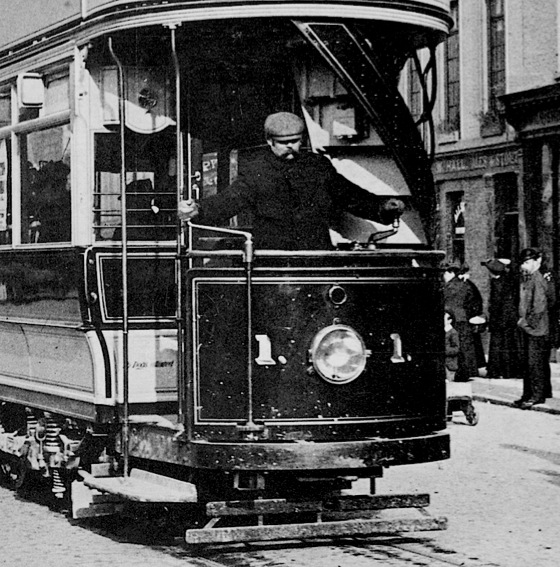
A motorman at the controls of Tramcar No 1 in Long Causeway on the opening day of operations, 24th January 1903. Uniforms were clearly a little late in arriving, hence the informal attire. Photo courtesy of the Tramways and Light Railway Society, with thanks to David Voice.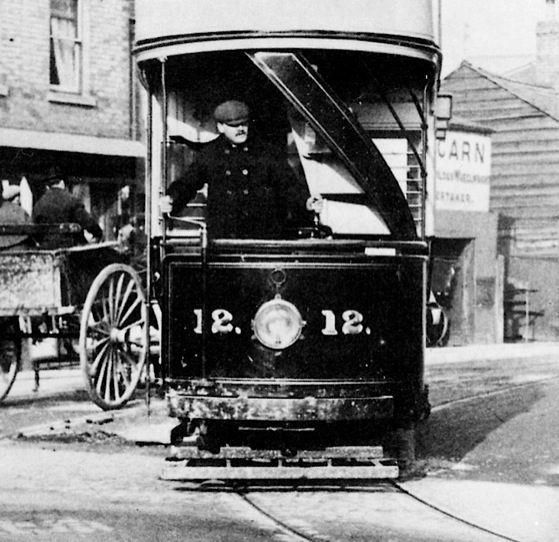
Tramcar No 12 negotiates the corner from Lincoln Road into Westgate — photo purportedly taken in 1904. Photo courtesy of the Tramways and Light Railway Society, with particular thanks to David Voice.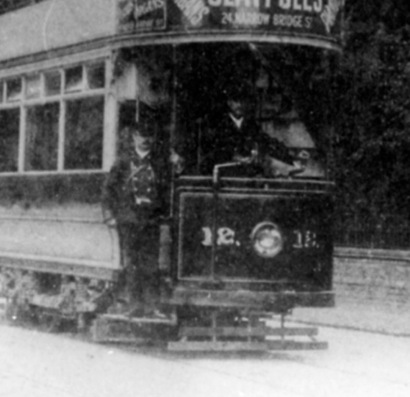
Tramcar No 12 in Eastfield Road on a Newark service — photo undated, but purportedly taken in 1905. Both men are wearing double-breasted jackets with lapels, and tensioned-crown peaked caps. Photo courtesy of the Tramways and Light Railway Society, with thanks to David Voice.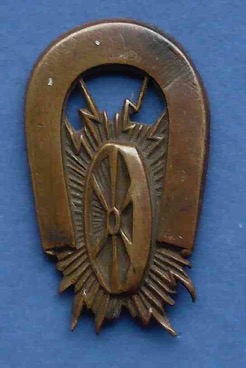
Standard British Electric Traction Company ‘Magnet & Wheel’ cap badge — brass. Author's Collection.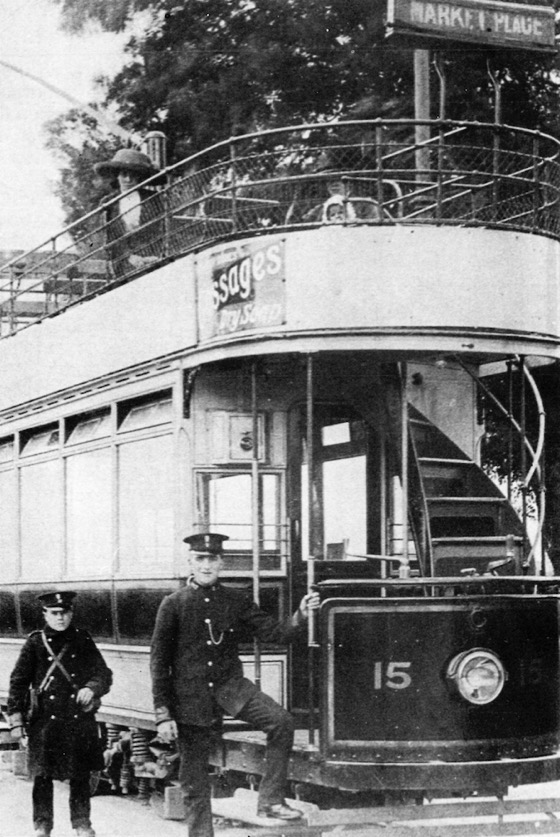
A conductor and a motorman pose with Tramcar No 15 at Newark Lane passing place on a service to the Market Place — photo undated, but possibly mid-to-late Edwardian. The tramcar was delivered in 1904 in Worcester Electric Traction Company livery, having been diverted from that system by the BETCo, which owned both companies. There would have been no rush to repaint a completely new tram, so it presumably ran in WETCo livery for several years. Photo courtesy of the Tramways and Light Railway Society, with thanks to David Voice.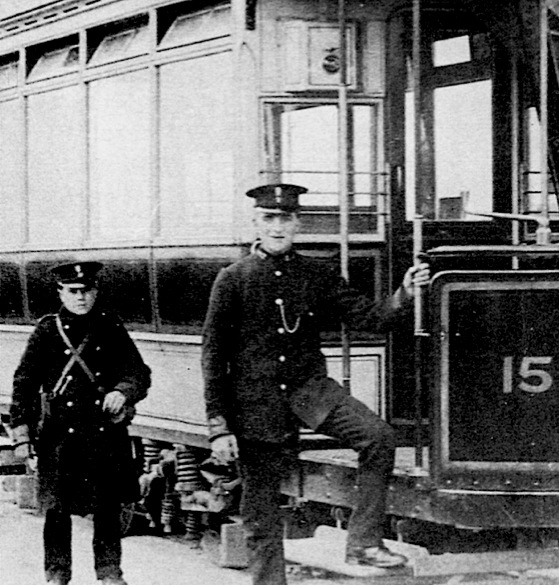
An enlargement of the above photograph showing the very youthful-looking conductor and the motorman, the former in double-breasted greatcoat and the latter in a single-breasted jacket. Both men are wearing peaked caps bearing the standard 'Magnet & Wheel' cap badge, with an employee number worn beneath.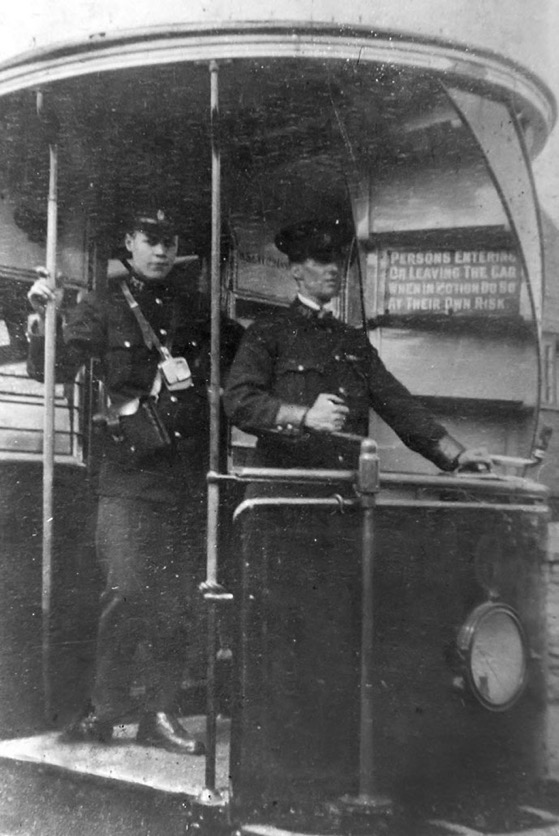
A conductor and motorman captured for posterity on the platform of Tramcar No 6 — photo undated, but probably taken after the Great War. The right-hand collar insignia can just be made out: 'P E T'. Source unknown.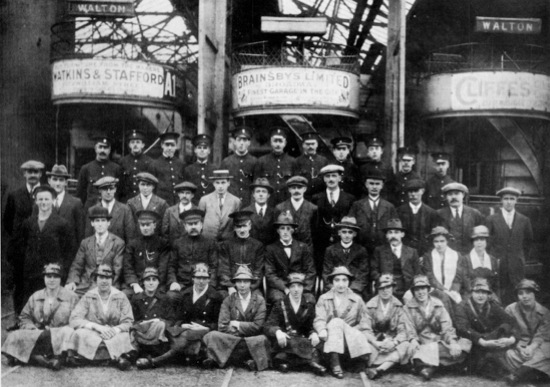
Staff photo taken in front of Lincoln Road tram depot in 1923. Peterborough was very unusual for an English tramway company in that it continued to employ female staff in significant numbers after the Great War, whereas the vast majority of operators rapidly released them in favour of the returning men. Photo courtesy of the Tramways and Light Railway Society, with thanks to David Voice.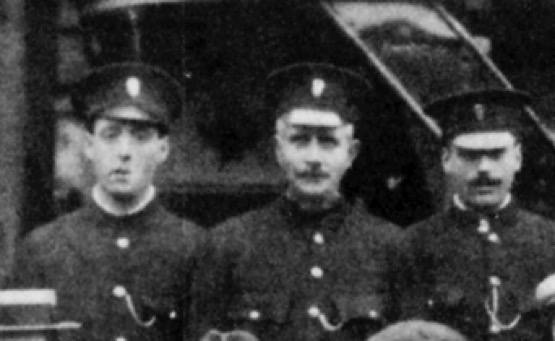
An enlargement of the above photograph showing three of the tramwaymen. None are wearing employee numbers on their caps.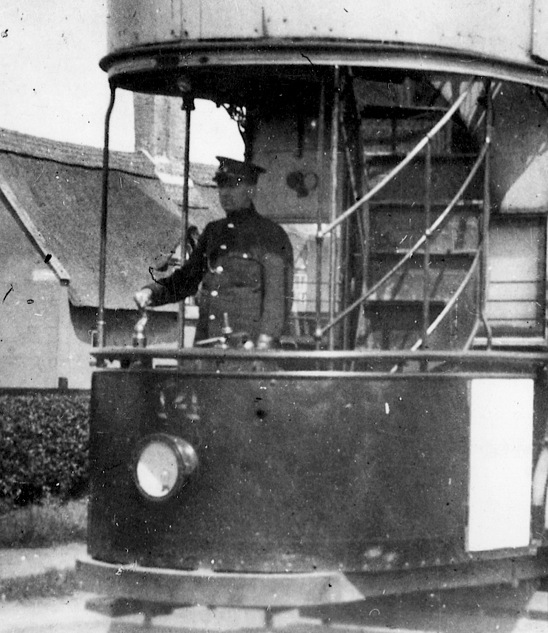
A motorman at the controls on Tramcar No 14 at the Newark Terminus in 1929, the vehicle by now looking somewhat battered. Photo courtesy of the Tramways and Light Railway Society, with thanks to David Voice.
Senior staff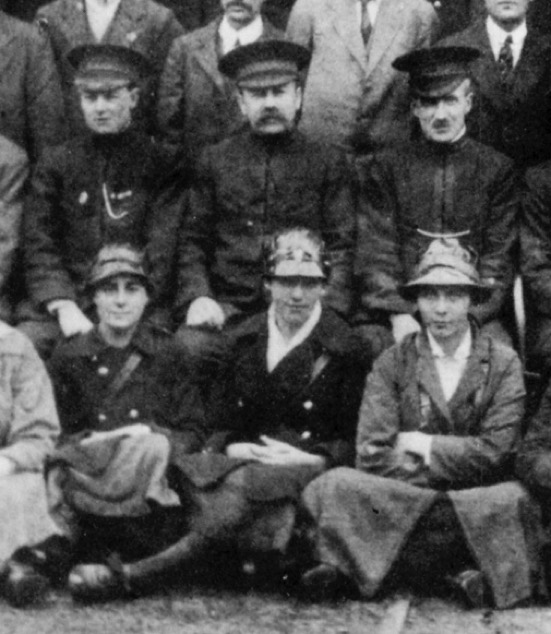
An enlargement of the staff photograph above, showing three inspectors and three conductresses.
Female staff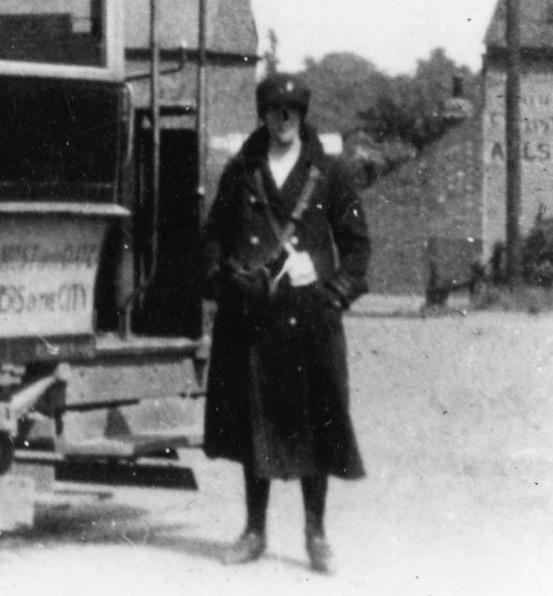
A PETCo conductress with Tramcar No 14 at the Newark Terminus in 1929 — taken from the same photo as that showing the motorman above. She would appear to be wearing a baggy peaked cap.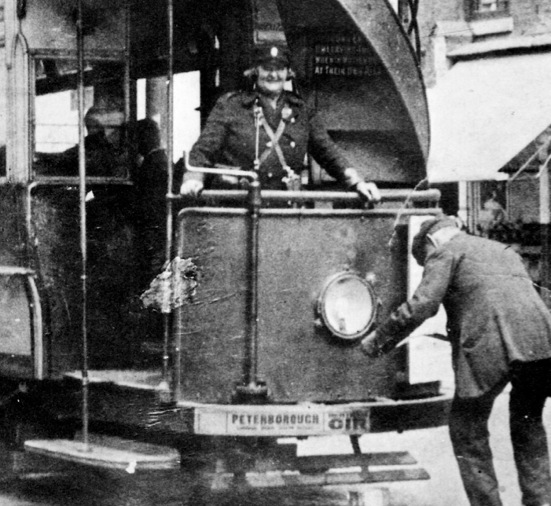
Conductress G Coles aboard what was destined to be Peterborough's last operational tram, No 12, in 1929. Photo courtesy of the Tramways and Light Railway Society, with thanks to David Voice.